![]()
![]()
![]()
Use LEFT and RIGHT arrow keys to navigate between flashcards;
Use UP and DOWN arrow keys to flip the card;
H to show hint;
A reads text to speech;
162 Cards in this Set
- Front
- Back
|
What are the functions of the vertebral column?
|
Provide vertical support for the body
Support the weight of the head Help maintain upright body position Help transfer axial skeletal weight to the appendicular skeleton of the lower limbs House and protect the delicate spinal cord and provide a passageway for spinal nerves connecting to the spinal cord |
|
|
What are the motions that occur at the vertebral column?
|
Flexion
Extension Hyperextension Lateral Bending Rotation |
|
|
What runs through the transverse foramen?
|
Vertebral Artery
|
|
|
Which vertebrae usually has a shorter bifid spinous process?
|
Cervical
|
|
|
What are the 2 parts of the intervertebral disc?
|
Annulus Fibrosis
Nucleus Pulposus |
|
|
What type of type of material is the annulus fibrosis?
|
Fibrocartilage
|
|
|
What type of material is the nucleus pulposus?
|
Gelatinous
|
|
|
What is the function of the intervertebral disc?
|
Facilitates motion, absorption and transmission of compression and other forces in the spine
|
|
|
What composes the thoracic cage?
|
Vertebrae
Ribs Sternum |
|
|
What is the deformation marked by a hunchback?
|
Kyphosis
|
|
|
What deformity is marked by swayback?
|
Lordosis
|
|
|
What is the most common spinal curvature disorder?
|
Scoliosis
|
|
|
What structures make up the neural arch?
|
Lamina
Pedicle |
|
|
Which vertebra doesn't have a body?
|
Atlas
|
|
|
What types of joint are the upper cervical joints?
|
Synovial
|
|
|
How many axes does the spine have?
|
3
|
|
|
How many degrees of freedom does the spine have?
|
6
|
|
|
What are the processes associated with the typical vertebra?
|
Transverse Process (2)
Spinous Process Superior Articular Facet (2) Inferior Articular Facet (2) |
|
|
What are the 2 main regions of the cervical spine?
|
Craniovertebral
Lower cervial |
|
|
What is the oblique orientation of the occipital bone condyles?
|
Posterior lateral to anterior medial
|
|
|
What is the importance of the oblique orientation of the occipital condyles?
|
Allow for it to articulate with the atlas and to improve the boney stability of the spine
|
|
|
What permits the passage of the spinal cord in the occipital bone?
|
Foramen Magnum
|
|
|
What are the arthrokinematics of C1-C2?
|
Planar; gliding
Most motion is side to side with spin, rotation, and tilt |
|
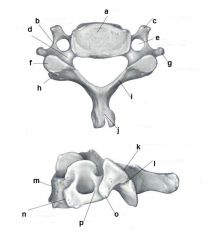
What is a?
|
Body
|
|
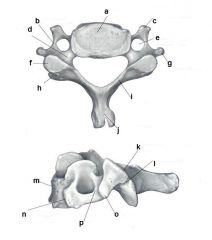
What is b?
|
Transverse Process
|
|
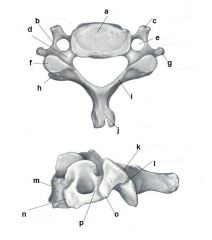
What is c?
|
Anterior Tubercle of Transverse Process
|
|

What is d?
|
Pedicle
|
|
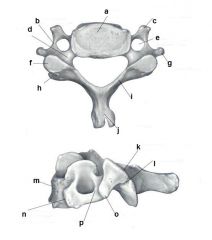
What is e?
|
Transverse Foramen
|
|
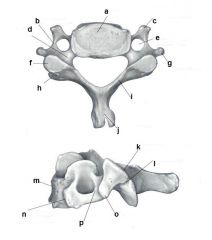
What is f?
|
Superior Articular Process
|
|

What is g?
|
Posterior Tubercle of Transverse Process
|
|

What is h?
|
Inferior Articular Process
|
|

What is i?
|
Lamina
|
|
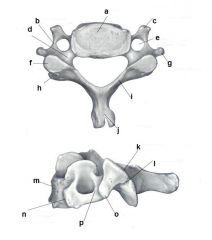
What is j?
|
(Bifid) Spinous Process
|
|
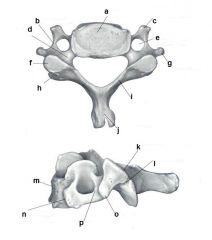
What is k?
|
Superior Articular Surface
|
|
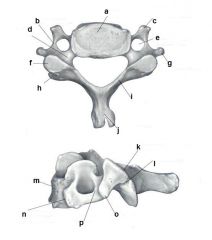
What is l?
|
Articular Pillar
|
|

What is m?
|
Body
|
|

What is n?
|
Anterior Tubercle of Transverse Process
|
|
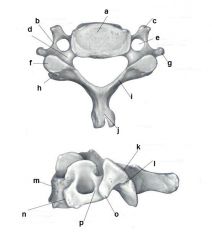
What is o?
|
Posterior Tubercle of Transverse Process
|
|

What is p?
|
Sulcus for Nerve
|
|
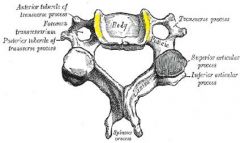
What is the highlighted area?
|
Uncinate Process
|
|
|
What is the change in orientation in the cervicle spine?
|
Superomedial at C2-C3
Superolateral at C7-T1 |
|
|
What is the importance of the change in orientation of the cervical vertebrae?
|
Allow for boney approximation and stability
|
|
|
What motion does the anterior longitudinal ligament prevent?
|
Excessive hyperextension
|
|
|
What does the posterior longitudinal ligament prevent?
|
Excessive flexion
|
|
|
Where does the supraspinal ligament attach?
|
On the posterior aspects of all of the spinous processes the entire length of the spine
|
|
|
Where does the ligamentum flavum attach?
|
From spinous process to spinous process of each vertebra
|
|
|
What motion does the ligamentum nuchae limit?
|
Flexion
|
|
|
What motion does the cruciform ligament limit?
|
Anterior translation of the the vertebral arch and flexion.
|
|
|
What motion does the apical ligament limit?
|
Traction
|
|
|
What motion does the alar ligament limit?
|
Lateral flexion
|
|
|
What is the purpose of the alar ligament?
|
Major stabilizer of the upper C-spine
|
|
|
What are characteristics of the intervertebral discs as we age?
|
Annulus fibrosis becomes discontinuous
Nucleus pulposis is smaller and has no gel- mostly fibrocartilage Clefts appear |
|
|
What are the arthrokinematics of the OA joint?
|
Roll and glide occur in opposite directions
|
|
|
What is the shape of the occipital condyles?
|
Convex
|
|
|
What is the shape of the facets on the atlas lateral masses?
|
Concave
|
|
|
What is a coupled motion?
|
When one motion occurs, because of the shape of the joint, another motion occurs
|
|
|
What is the orientation of the OA joint?
|
Postero-lateral to anteromedial
|
|
|
What is the main motion of the OA joint?
|
Flexion/extension
|
|
|
What are the osteokinematics of the OA joint?
|
Flexion/extension: 15-35 degrees
Lateral flexion: 5-10 degrees Rotation: 5 degrees |
|
|
What is the axis of rotation of the OA joint?
|
Sitting above the floor of the occiput
|
|
|
What is the main motion that occurs at the AA joint?
|
Rotation
|
|
|
What are the osteokinematics of the AA joint?
|
Rotation: 40-45 degrees
Flexion/extension: 15-20 degrees Side bending: 5-10 degrees |
|
|
How does the cartilage affect joint motion in the AA joint?
|
Creates convex on convex surface
Slope less steep on posterior |
|
|
What is the coupled motion that typically occurs at the AA joint?
|
Ipsilateral sidebending and rotation
|
|
|
What are the arthrokinematics at the AA joint?
|
Contralateral anterior motion/ipsilateral posterior motion
|
|
|
At the AA joint, what imparts the tilt of the atlas?
|
Lateral flexion and lateral translation
|
|
|
What acts as a washer between the occiput and the axis?
|
Atlas
|
|
|
What is the paradoxical motion of the atlas?
|
Atlas can flex or extend during craniovertebralflexion depending on how compression forces are placed relative to the fulcrum (axis of motion)
|
|
|
What is the combined OA and AA motions that occur during side bending?
|
Side bending L will impart L rotation of the axis with relative R rotation of the atlas
|
|
|
Which of the following motions happen at the atlas and axis if I sidebend to the left?
|
Left rotation of the axis
Right rotation of the atlas |
|
|
What type of joints are the lower cervical spine joints?
|
Amphiarthroidal
Zygapophyseal Joints |
|
|
What type of motion occur at the lower cervical spine?
|
Planar
|
|
|
During extension, what direction does the inferior articular facet glide (C-spine).
|
Inferior
|
|
|
What is the axis for the saddle joints of the C-spine?
|
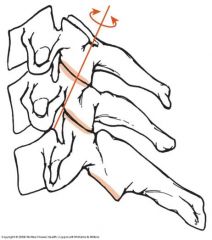
Occurs in the plane of the facets-axis perpendicular
|
|
|
What is capital flexion/extension?
|
Flexion/extension through the upper C-spine
|
|
|
What is cervical flexion/extension?
|
Flexion/extension through the lower C-spine
|
|
|
What is the open pack position of the C-spine?
|
Slight extension
|
|
|
What is the closed pack position of the C-spine?
|
Full Extension
|
|
|
What is the capsular pattern of the C-spine?
|
Side flexion and rotation equally limited followed by extension
Flexion less affected |
|
|
What is the normal end feel of the C-spine?
|
Firm
|
|
|
What are normal osteokinematics of the combined motions at the C-spine?
|
Flexion AROM- 40-60 degrees
Extension AROM- 60-80 degrees Lateral flexion- 40-50 degrees Rotation- 70-90 degrees |
|
|
What motions are produced by the suboccipital muscles?
|
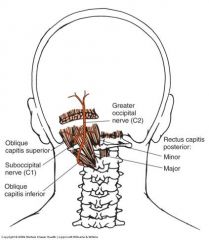
Extension
Ipsilateral rotation of head |
|
|
What motions are produced by the transversospinalis?
|
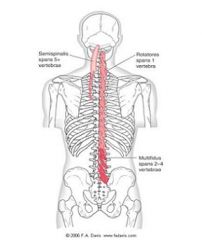
Extension of spine
Contralateral rotation |
|
|
How many levels do the rotatores span?
|
1
|
|
|
How many levels does the multifidus span?
|
2-4
|
|
|
How many levels does the semispinalis span?
|
4-6
|
|
|
What motions are produced by the semispinalis?
|
Extension
Increase lordosis Lateral flexion |
|
|
Which joint in the C-spine limits side-bending?
|
Uncovertebral joint
|
|
|
Which joint in the C-spine facilitates side-bending?
|
Zygapophyseal
|
|
|
If the suboccipital muscles contract unilaterally, which motion is produced?
|
Ipsilateral rotation
Some side-bending |
|
|
Which muscle is specifically involved in increased lordosis?
|
Semispinalis
|
|
|
What is the motion produced by the splenius capitis and cervicis?
|
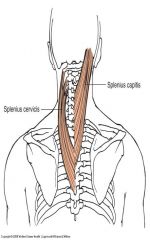
Unilateral contraction
rotates and laterally bends the head and neck Bilateral contraction will extend the neck and head. Accentuate cervical lordosis Postural clinical considerations? |
|
|
What actions does the levator scapulae facilitate?
|
Ipsilateral side-bending and rotation of C-spine
Elevates scapula and does downward rotation |
|
|
What are the 3 muscle groups of the erector spinae?
|
Spinalis
Longissimus Iliocostalis |
|
|
What motion is produced by bilateral contraction of the erector spinae?
|
Extension
|
|
|
What motion is produced by unilateral contraction of the erector spinae?
|
Sideflex/rotate ipsilateral
Lateral stabilization |
|
|
What actions does the upper trapezius facilitate?
|
Ipsilateral sidebending and contralateral rotation
Extension |
|
|
What are the flexors of the head and neck?
|
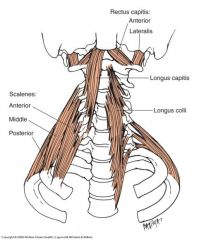
Longus Capitis/Cervicis
Rectus Capitis Anterior/Lateralis |
|
|
What are the motions produced by the longus capitis and longus cervicis?
|
Flexion of head and neck
Lateral Flexion/Ipsilateral side-bending |
|
|
What is the motion produced by the rectus capitis anterior and rectus capitis lateralis?
|
Flexion of head
Potention for lateral head flexion |
|
|
Which muscle is especially involved in whiplash?
|
Longus Capitis
|
|
|
What is the motion produced by the SCM?
|
Flexes the neck
Laterally bends and rotates the head to the opposite side |
|
|
Which muscle is involved with torticollis?
|
SCM
|
|
|
Which motions are produced by the scalene muscles?
|
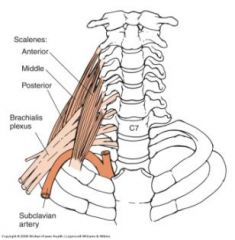
Neck flexion and laterally bending
Contralat. rotation Stabilization Rib Elevation |
|
|
Which muscle group is clinically relevant to compression syndrome?
|
Scalenes
|
|
|
What is a force couple at the C-spine?
|
Upper Trapezius
SCM |
|
|
Muscles maintain ______ of peak force capacity through ROM
|
80%
|
|
|
What can have a major impact on muscle activation?
|
Posture
|
|
|
What is the concept of the neutral zone of posture?
|
Region of little passive resistance
Staying within the neutral zone requires relatively small amounts of muscle force-Thus less compression force and joint reaction forces |
|
|
What is hangman's fracture?
|
A fracture of C2
|
|
|
What are functions of the thoracic cage?
|
Protection
Respiration Muscle attachment |
|
|
The thoracic vertebral bodies _______ in size from superior to inferior.
|
increase
|
|
|
The kyphotic curve is covex in which direction?
|

Posterior
|
|
|
What is the orientation of the superior and inferior articular process?
|
Nearly vertical
In general: Superior face posterior and slightly lateral, inferior: anterior and slightly medial. Transitional vertebrae exceptions lower down |
|
|
How do the ribs articulate for the costal facets on the vertebrae?
|
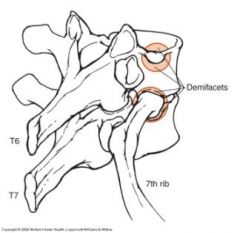
2ndrib articulates with a demifaceton the inferior lateral body of T1 and the superior lateral body of T2
|
|
|
What lends to stability in the thoracic spine?
|
Capsular and other ligaments, Discs
Bony congruency/ orientation of processes Rib articulations |
|
|
What are the normal osteokinematics of the T-spine?
|
Flexion AROM: 20-45
Extension AROM: 20-45 Lateral flexion:–20-40 Rotation: 35-50 |
|
|
What is the open pack position of the T-spine?
|
Neutral
|
|
|
What is the closed pack position of the T-spine?
|
Extension
|
|
|
What is the capsular pattern of the T-spine?
|
Side flexion and rotation equally limited, then extension
|
|
|
What is a unique feature of the thoracic spinous process?
|
Long
Projects posterior/inferior |
|
|
What is a unique feature of the thoracic transverse process?
|
Lateral and posterior projection
|
|
|
What is a unique feature of the superior/inferior articular processes of the thoracic vertebrae?
|
Nearly vertical
In general: Superior face posterior and slightly lateral, inferior: anterior and slightly medial. Transitional vertebrae exceptions lower down |
|
|
What is the orientation of the spinous processes throughout the thoracic vertebrae?
|
T1-3 approx same vertebral level
T4-6: Halfway between T process of same level and vertebra below T7-10: One level below T11-Similar to T6 T12 Similar to T3 |
|
|
What are considerations for the narrow vertebral canal in the thoracic spine?
|
Potential for more injury to spinal cord
Necessity for more stability |
|
|
Which ribs are true ribs?
|
1-7
|
|
|
Why are they called true ribs?
|
At the anterior body wall, the true ribs connect individually to the sternum by separate cartilaginous extensions called costal cartilages.
|
|
|
Which ribs are false ribs?
|
8-12
|
|
|
Why are they called false ribs?
|
Because their costal cartilages do not attach directly to the sternum. The costal cartilages of ribs 8–10 fuse to the costal cartilage of rib 7 and thus indirectly articulate with the sternum.
|
|
|
Which ribs are floating ribs?
|
The last two pairs of false ribs (ribs 11 and 12)
|
|
|
Why are they called floating ribs?
|
Because they have no connection with the sternum
|
|
|
What are the 5 main joints of the thoracic cage?
|
Interbody
Facet Vertebrocostal Sternocostal Costocondral |
|
|
What type of joints are the interbody joints?
|
Symphyses
Amphiarthrotic |
|
|
What type of joints are the facet (zygapophyseal)c joints?
|
Synovial
Planar |
|
|
What type of joint is the vertebrocostal?
|
Synovial
Planar |
|
|
What type of joint is the sternocostal joint?
|
Synovial planar
|
|
|
What is the joint that consists of endplate of adjacent vertebral bodies joined by fibrocartilage discs?
|
Interbody joints
|
|
|
The relatively symmetric dimensions of the interbody joints of the thoracic vertebrae lend to what?
|
Little contribution to kyphosis
|
|
|
What are the joints between the superior and inferior articular processes?
|
Zygapophyseal (Facet) Joints
|
|
|
Rotation at the thoracic spine is couple with which other motion?
|
Sidebending
|
|
|
At the thoracic spine, which direction does slide occur in relative to rotation?
|
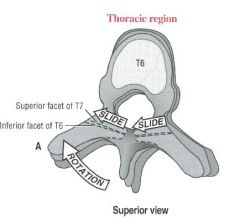
Same
|
|
|
In the thoracic spine, during side-bending, which direction
|
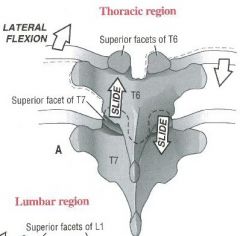
Ipsilateral: Same direction
Contralateral: Opposite direction |
|
|
Although the costal joints are planar, the ribs rotate in ____ directions.
|
3
|
|
|
T/F Joint axis orientation of the costal joints is different from upper to lower ribs.
|
True
|
|
|
Rib motion allows for increase in which directions?
|
Anterior-Posterior
Transverse |
|
|
What are the primary motion of the ribs?
|
Elevation
Depression |
|
|
The motions of the rib cage are described figuratively as what?
|
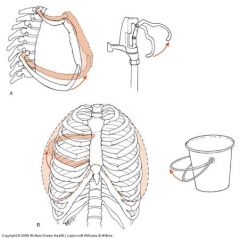
Pump Handle
Bucket Handle |
|
|
Based on the axis of rotation difference between upper and lower ribs, What motion (pump handle or bucket handle) would predominate in the upper thoracic cage?
|
Pump Handle
|
|
|
Each rib pair forms a ring, does that make it open chain, or closed chain?
|
Closed Kinetic Chain
|
|
|
What is the rib motion is response to thoracic motion?
|
T flexion= rib depression
T extension= rib elevation Sidebending: ipsilateral approximation of ribs Rotation: Contralateral anterior/ipsilateral posterior position of rib |
|
|
What is the motion of the manubriosternal joint during elevation of the ribs?
|
Slight Flexion
|
|
|
What is the function of twisting costal cartilage?
|
Stores elastic energy
Assists with expiration |
|
|
What are key characteristics of the thoracic vertebrae?
|
Do not have a bifid spinous process
Spinous process hangs down to limit extension Have transverse foramen |
|
|
What motions are the trapezius and rhomboids involved in at the T-spine?
|
Extension
Sidebending Contralateral Trunk Rotation |
|
|
What motions are the latissimus dorsi involved in at the T-spine?
|
Extension
Sidebending Ipsilateral rotation |
|
|
What is an example of force coupling at the T-spine?
|
Trapezius and lats performing trunk rotation
|
|
|
What motions does the erector spinae perform at the T-spine?
|
Extension
Ipsilateral sidebending Ipsilateral rotation Contract during active extension and eccentrically through partial flexion |
|
|
How does type I and Type II muscle fiber type effect role in function of the erector spinae?
|
Erector spinae is mostly type I fibers which can avoid fatigue better and can act better as "stabilizers", but they sometimes act like type II fibers
|
|
|
Which intercostal muscles are involved in inspiration?
|
External intercostals
|
|
|
What are characteristics of the diaphram?
|
Is an internally placed, dome-shapedmuscle.
Forms a partitionbetween the thoracic and abdominal cavities. The most important muscle associated with breathing. The muscle fibers converge from its margins toward a fibrous central tendon. A strong aponeurosis is the insertion tendon for all peripheral muscle fibers. |
|
|
Are the thoracic discs smaller or larger in height than cervical discs?
|
Smaller
|
|
|
Why does the t-spine have so much rotation?
|
The orientation of the facets allows the superior articular facet to rotate more freely.
|

